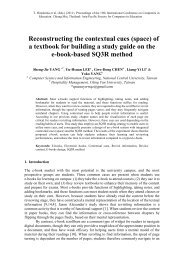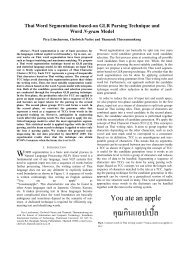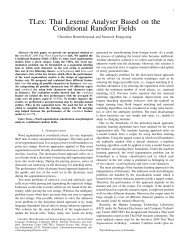ab initio and density functional studies of polythiophene ... - Nectec
ab initio and density functional studies of polythiophene ... - Nectec
ab initio and density functional studies of polythiophene ... - Nectec
You also want an ePaper? Increase the reach of your titles
YUMPU automatically turns print PDFs into web optimized ePapers that Google loves.
NECTEC Technical Journal, Vol. II, No. 9 215AB INITIO AND DENSITY FUNCTIONAL STUDIES OFPOLYTHIOPHENE ENERGY BAND GAPArnold C. Alguno *a , Wilfredo C. Chung a , Rol<strong>and</strong>o V. Bantaculo b , Reynaldo M. Vequizo b ,Hitoshi Miyata c , Edgar W. Ignacio *d <strong>and</strong> Angelina M. Bacala *ba College <strong>of</strong> Arts <strong>and</strong> Sciences, NORMISIST, Ampayon, Butuan City, Philippinesb Department <strong>of</strong> Physics, MSU-IIT, Iligan City, Philippinesc Department <strong>of</strong> Physics, Niigata University, Ikarashi, Jap<strong>and</strong> Department <strong>of</strong> Chemistry, MSU-IIT, Iligan City, PhilippinesABSTRACT – The energy b<strong>and</strong> gap <strong>of</strong> intrinsic thiophene monomer <strong>and</strong> dimer were calculated usingHartree-Fock (HF) <strong>and</strong> <strong>density</strong> <strong>functional</strong> theory (DFT) methods employing various combinations <strong>of</strong>exchange <strong>and</strong> correlation <strong>functional</strong>s with electron core potential (ECP) split valence basis sets. HFoverestimates b<strong>and</strong> gap by up to 6.10 eV for thiophene monomers <strong>and</strong> dimers. DFT calculations with hybrid<strong>functional</strong>s (B3LYP <strong>and</strong> B3P86) give an excellent results (4.06 eV <strong>and</strong> 4.11 eV) which are in good agreementwith the experimental energy b<strong>and</strong> gap (4.05 eV).KEYWORDS -- Energy b<strong>and</strong> gap; <strong>density</strong> <strong>functional</strong> theory; <strong>ab</strong> <strong>initio</strong>; HOMO-LUMO; thiophene.1. Introduction To design a low b<strong>and</strong> gap polymer, it is desir<strong>ab</strong>le to start withDue to its chemical st<strong>ab</strong>ility, high conductivity upon doping,<strong>and</strong> their non-linear optical properties, <strong>polythiophene</strong> isamong the widely studied conjugated organic polymers,experimentally <strong>and</strong> theoretically [1]. During the recent yearssystematic efforts were aimed at investigating the molecular<strong>and</strong> electronic structure <strong>of</strong> thiophene oligomers <strong>and</strong> itsderivatives [2, 3, 4, 5, 6, 7].The energy gap between valence <strong>and</strong> conduction b<strong>and</strong> <strong>of</strong>polymer is related to the lowest allowed energy <strong>of</strong> itsmonomer units <strong>and</strong> to the b<strong>and</strong>width resulting from theoverlap between the monomer orbitals as shown in Figure 1[2]. The energy b<strong>and</strong> gaps obtained from b<strong>and</strong> structurecalculations for solids are analogous to Highest OccupiedMolecular Orbital (HOMO) – Lowest Unoccupied MolecularOrbital (LUMO) energy differences in molecules.LUMO∆EHOMOE gmonomer units with small excitation energies. A prior ideaon the estimate is <strong>of</strong>ten useful. One way to obtain excitationenergies is to calculate the energy <strong>of</strong> the ground <strong>and</strong> excitedstate explicitly <strong>and</strong> to take the energy difference. Thecommonly accepted structure <strong>of</strong> <strong>polythiophene</strong> is a linearchain <strong>of</strong> monomers α - α′ (2, 5) bounded by carbon [3] asshown in Figure 2.An initial estimate <strong>of</strong> the b<strong>and</strong> gap can be carried out using<strong>density</strong> <strong>functional</strong> theory (DFT). DFT is very attractive incalculations involving finite system because even the lowestlevel <strong>of</strong> DFT – the Local Spin Density Approximation(LSDA) – includes some electron correlation. This isextremely important in the design <strong>of</strong> conducting organicpolymers which have an extended π system. Although theLSDA eigenvalue differences underestimate the b<strong>and</strong> gapcompared to experiment, the shift is almost vertical <strong>and</strong> verysystematic [2].DFT method had successfully been used to study b<strong>and</strong> gaps<strong>of</strong> conjugated organic polymers where the HOMO/LUMOdifference provide good estimate <strong>of</strong> the excitation energy.While there is some controversy surrounding theinterpretation <strong>of</strong> DFT orbitals energies, we find thatHOMO/LUMO energy difference <strong>of</strong>fers a very good estimate<strong>of</strong> b<strong>and</strong> gaps. It should be noted that the HOMO/LUMOenergy difference at <strong>ab</strong> <strong>initio</strong> level does not closely relate toexcitation energies due to the <strong>ab</strong>sence <strong>of</strong> orbital relaxationeffects [8].Figure 1. Relationship between HOMO-LUMO levels <strong>of</strong>finite <strong>and</strong> b<strong>and</strong> gaps <strong>of</strong> the infinite system.2. Computational DetailsInitial geometries were optimized at Hartree-Fock (HF) level<strong>of</strong> theory <strong>and</strong> further reoptimized using DFT methods toinclude correlation corrections. In this study, an exchange
NECTEC Technical Journal, Vol. II, No. 9 216<strong>functional</strong> which was proposed by Becke [11a] in 1988 usinga gradient-corrected correlation <strong>functional</strong> <strong>of</strong> Lee, Yang <strong>and</strong>Parr [11b, 11c] was employed. Hybrid <strong>functional</strong> are alsoused, the Becke’s three-parameter <strong>functional</strong> (B3) [11d]which defines the exchange <strong>functional</strong> as the linearcombination <strong>of</strong> Hartree-Fock, local <strong>and</strong> gradient-correctedexchange terms. The B3 hybrid <strong>functional</strong> was used incombination with the correlation <strong>functional</strong>s <strong>of</strong> Lee, Yang<strong>and</strong> Parr <strong>and</strong> non-local correlation expression provided by thePerdew 86 (P86) [11e].The type <strong>of</strong> basis set is that <strong>of</strong> Stephens/Basch/Krauss ECPsplit valence (CEP-31G), augmented with polarizationfunctions on heavy atoms (CEP-31G*), diffused function(CEP-31+G) <strong>and</strong> polarized functions (6-31G**). These basissets were employed because some previous calculations [6]suggest that their results are in good agreement with theexperimental values <strong>of</strong> the energy b<strong>and</strong> gap <strong>of</strong> differentpolymeric system.The vibrational frequency calculations were carried out tocharacterize the stationary points. Symmetry constraintswere applied whenever possible.All calculations were performed using the Gausian ’94 [9]<strong>and</strong> GAMESS [10] suites <strong>of</strong> quantum chemistry programsrunning under Beowulf cluster, SunSparc station, <strong>and</strong> DECalpha machines.3. Results <strong>and</strong> Discussion3.1 GeometriesThe optimized results using hybrid DFT <strong>functional</strong>(B3LYP/CEP-31G*) are shown in Figure 2. This is thest<strong>ab</strong>le geometry <strong>of</strong> thiophene monomer <strong>and</strong> dimer. With theHF/6-31G* <strong>and</strong> B3LYP/CEP-31G*, the bond length are up to±0.025Å <strong>and</strong> ±0.046Å, respectively when compared toexperimental values. The bond angles agree very closely (towithin ±0.33 o ) with experiment. Pure <strong>and</strong> hybrid <strong>functional</strong>sgeometries are almost identical. Compared to HF theory,DFT yields longer C=C double bonds. Thus, at HF, π-electrons is more localized. This is most likely due to theneglect <strong>of</strong> electron correlation. For geometry calculations,HF revealed more accurate estimates, indicating that it maynot be necessary to perform DFT calculations to obtain goodgeometries in this case. Complete documentation <strong>of</strong>geometries is listed in T<strong>ab</strong>le 1.3.2 Energy B<strong>and</strong> GapsSpectroscopic data for organic π-systems are usuallydetermined either in solution or in the solid state (crystal orthin film). Since our calculations are for isolated molecules inthe gas phase, we have attempted to compare our calculationto experimental results in solution.T<strong>ab</strong>le 2 summarizes the energy b<strong>and</strong> gap <strong>of</strong> intrinsicthiophene monomers <strong>and</strong> dimers at HF, BLYP, B3LYP <strong>and</strong>B3P86 with various combinations <strong>of</strong> basis sets. As expected,the RHF energy b<strong>and</strong> gap <strong>of</strong> intrinsic thiophene oligomersoverestimates the excitation energy because <strong>of</strong> the <strong>ab</strong>sence <strong>of</strong>correlation contribution [16]. Little improvement <strong>of</strong> theenergy b<strong>and</strong> gap is obtained in applying a higher level basisset; the <strong>ab</strong>solute error is 5.51-6.10 eV. It is expected that thepercent error decrease with increasing length <strong>of</strong> polymers atthis level <strong>of</strong> theory [9]. The pure DFT <strong>functional</strong> (BLYP)underestimate the energy b<strong>and</strong> gap by up to 1.77 eVcompared to the experimental excitation energy. Hybrid DFTmethod (B3LYP <strong>and</strong> B3P86) yielded HOMO-LUMO energydifference which are in good agreement with the experiment.The DFT (B3LYP <strong>and</strong> B3P86) energy b<strong>and</strong> gaps forthiophene dimer give an error <strong>of</strong> only up to 0.22 eV <strong>and</strong> 0.17eV, respectively. The two hybrid <strong>functional</strong>s lead to almostidentical results. Applying more comprehensive basis ddidnot significantly improve the energy b<strong>and</strong> gap <strong>of</strong> thiopheneoligomer. This study shows that by using hybrid DFT<strong>functional</strong>s, a substantial improvement in the excitationenergy can be obtained. The same observation was alsoreported previously by other workers [1, 2] using differentpolymeric system.Figure 2. Structures <strong>of</strong> thiophene (a) monomer (b) dimer. Calculated bond distances are given in angstrom (Å) atB3LYP/CEP-31G*.
NECTEC Technical Journal, Vol. II, No. 9 217T<strong>ab</strong>le 1. Optimized structure <strong>of</strong> thiophene oligomers at 6-31G* (HF) <strong>and</strong> CEP-31G* (DFT).Parameter RHF error BLYP error B3LYP error B3P86 error Expt.MonomerBond lengthC 2 – H 6 1.074 0.004 1.095 0.017 1.088 0.010 1.088 0.010 1.078S 1 – C 2 1.726 0.012 1.764 0.050 1.749 0.035 1.737 0.023 1.714C 4 = C 5 1.345 0.025 1.404 0.034 1.393 0.023 1.391 0.021 1.370C 3 – C 4 1.437 0.014 1.455 0.032 1.449 0.026 1.443 0.020 1.423Bond angleS 1 C 2 C 3 111.83 0.33 111.43 0.07 111.50 0.000 111.51 0.01 111.50C 2 C 3 C 4 112.52 0.13 112.63 0.02 112.51 0.140 112.39 026 112.65C 4 C 3 H 7 124.11 0.12 124.21 0.02 124.23 0.000 124.32 0.09 124.23DimerBond lengthS 1 – C 5 1.736 0.012 1.766 0.042 1.750 0.026 1.739 0.015 1.724C 5 – C 2 1.481 0.017 1.476 0.012 1.473 0.009 1.468 0.004 1.464C 4 = C 5 1.367 0.014 1.403 0.050 1.391 0.038 1.390 0.037 1.353C 3 – C 4 1.449 0.018 1.448 0.017 1.443 0.012 1.437 0.006 1.431C 4 – C 3 1.375 0.019 1.414 0.058 1.402 0.046 1.339 0.043 1.356Bond distances <strong>and</strong> bond angles are given in Å <strong>and</strong> degrees, respectively.T<strong>ab</strong>le 2. HOMO-LUMO energy differences (energy b<strong>and</strong> gap in eV) at various levels <strong>of</strong> theory.MonomerDimer6-31G 6-31+G 6-31G* 6-31G** 6-31G 6-31+G 6-31G* 6-31G**RHF 12.6066 11.4289 12.6888 12.6700 9.9676 9.5622 9.7031 10.1500CEP-31G CEP-31+G CEP-31G* 6-31G** CEP-31G CEP-31+G CEP-31G* 6-31G**BLYP 4.2298 4.2325 4.2415 4.4400 2.6741 2.2771 2.6790 2.8000B3LYP 5.8426 5.8265 5.8570 6.1200 4.0491 4.0417 4.0572 4.2700B3P86 5.9177 5.9153 5.9357 6.1800 4.1008 4.1049 4.1092 4.2200Expt’l. value 5.2300 a 4.0500 ba ref. [18], b ref. [19]4. Concluding RemarksWe have shown that a substantial improvement <strong>of</strong> DFTenergy b<strong>and</strong> gaps can be achieved with hybrid DFT<strong>functional</strong>s. Vertical excitation energies <strong>of</strong> thiopheneoligomers were approximately reproduced with ±0.22 eV <strong>of</strong>the corresponding experimental results (solution phase).Polythiophene presents special problems in computationalmodeling because <strong>of</strong> its extended molecular system. As aconsequence, their properties may arise from secondary <strong>and</strong>tertiary structure effects, as well as from the primarymicrostructure. Their size <strong>and</strong> structure complexity causesthe difficulty, even without worrying <strong>ab</strong>out inter chainpackingeffect.Energy b<strong>and</strong> gap calculated using hybrid DFT <strong>functional</strong>syielded estimates <strong>of</strong> excitations energies which are in goodagreement with experimental value. The use <strong>of</strong> DFT hybrid<strong>functional</strong>s therefore will lead to a significant improvement<strong>of</strong> the energy b<strong>and</strong> gap relative to those computed by HFmethods. This study also indicated that the presences <strong>of</strong>polarized functions on heavy atoms as well as thecorresponding diffused functions are crucial in thecomputations <strong>of</strong> the energy b<strong>and</strong> gap <strong>of</strong> thiophene oligomers.We hope that this contribution will stimulate thecomputational modeling community for the discussion <strong>of</strong>intrinsic <strong>polythiophene</strong>s as well as other conductingpolymers. It is further suggested that longer thiopheneoligomer chains up to 11 units or even longer with higherbasis sets will be used so that a more accurate energy b<strong>and</strong>gap could be predicted though this requires a very highcomputational cost.AcknowledgmentsWe thank Pr<strong>of</strong>. Ronald <strong>and</strong> Mr. Marvin Fern<strong>and</strong>ez for manyfruitful discussions. Likewise, thank is due to Mr. Allen S.Dahili for many helpful assistance. This study wasconducted through the scholarship grant supported by theCommission on Higher Education – Mindanao AdvancedEducation Project (CHED-MAEP).
NECTEC Technical Journal, Vol. II, No. 9 218Reference[1] Salzner, U., Lagowski, J. B., Pickup, P. G. <strong>and</strong> Poirier,A., Synth. Met. 96 (1998) 177-189.[2] Salzner, U., Lagowski, J. B., Pickup, P. G. <strong>and</strong> Poirier,A., J. Comp. Chem. 18, 15, 1943-1953, 1997.[3] Salzner, U., Lagowski, J. B., Pickup, P. G. <strong>and</strong> Poirier,A., Synth. Met. 98 (1999) 221-227.[4] Nakanishi, H, et al. J. Org. Chem. 1998, 63, 8632-8633.[5] Lathti, P. M., Obrzut, J., Karasz, F. E., Macromolecules,1987, 20, 2023.[6] Smith, James Richard, Electrosynthesis <strong>of</strong> NovelPolyheterocycles, Ph.D. Dissertation, Unpublished,School <strong>of</strong> Pharmacy & Biomedical Sciences, University<strong>of</strong> Portsmouth, Portsmouth, UK, 1995.[7] Irle, Stephan <strong>and</strong> Lischka, Hans. J. Chem. Phys. 103 (4)1995.[8] Foresman, J. B. <strong>and</strong> Frisch, Æ., Exploring Chemistrywith Electronic Structure Methods, 2 nd ed. Gaussian,Inc., Pittsburgh, PA. 1995.[9] Gaussian 94, Revision B.2. M. J. Frisch, G. W. Trucks,H. B. Schlegel, P. M. W. Gill, B. G. Johnson, M. A.Robb, J. R. Cheeseman, T. Keith, G. A. Petersson, J. A.Montgomery, K. Raghavachari, M. A. Al-Laham, V. G.Zakrzewski, J. V. Ortiz, J. B. Foresman, C. Y. Peng, P.Y. Ayala, W. Chen, M. W. Wong, J. L. Andres, E. S.Replogle, R. Gomperts, R. L. Martin, D. J. Fox, J. S.Binkley, D. J. Defrees, J. Baker, J. P. Stewart, M. Head-Gordon, C. Gonzalez, <strong>and</strong> J. A. Pople, Gaussian, Inc.,Pittsburgh PA, 1995.[10] GAMESS Version = 22 Nov 1995 from Iowa StateUniversity, M.W.Schmidt, K.K.Baldridge, J.A.Boatz,S.T.Elbert, M.S.Gordon, J.H.Jensen, S.Koseki,N.Matsunaga, K.A.Nguyen, S.J.Su, T.L.Windus,Together With M.Dupuis, J.A.Montgomer. J. Comp.Chem. 14, 1347-1363 (1993).[11] (a) A. D. Becke, Phys. Rev., A38, 3098 (1988). (b) C.Lee, W. Yang <strong>and</strong> R. G. Parr, Phys. Rev., B37, 785-789(1988). (c) B. Miehlich, A. Savin, H. Stoll <strong>and</strong> H.Preuss, Chem. Rev. Lett, 157, 200 (1989). (d) A. D.Becke, J. Chem. Phys. 98, 5648-5652 (1993). (e) J. P.Perdew, Phys. Rev. B33, 8822-8824 (1986).[12] Slater, J.C., Quantum Theory <strong>of</strong> Molecules <strong>and</strong> solids,McGraw-Hill: New York, 1974, Vol. 4.[13] Vosko, S.H., Wilk, L., Nusair, M., Can, J. Phys. 1980,58, 1200.[14] Becke, A.D., J. Chem. Phys. 1993, 98, 1372.[15] P. Walters, M. Stahl, BABEL Program (version 1.1)Copyright ©1992, 93, 94, Dolota Research Group,Department <strong>of</strong> Chemistry, University <strong>of</strong> Arizona.[16] Hyperchem Release3 . Windows MolecularModelling System, Copyright ©1993, Hypercube, Inc.<strong>and</strong> Autodesk, Inc. Developed by Hypertube, Inc.[17] R.M. Dreiler <strong>and</strong> E.K.U. Gross, Density FunctionalTheory, Springer, Berlin, 1990.[18] Simmons, W.W., H<strong>and</strong>book <strong>of</strong> Ultraviolet Spectra;Sdler Res. L<strong>ab</strong>.: Philadelphia.[19] Colditz, R., Grebner, D., Helbig, M., Rentsch, S., Chem.Phys.1995, 201, 309.[20] O. Kwong <strong>and</strong> M.L. McKee, J. Phys. Chem. B2000,104, 1686-1694.[21] Theoretical Studies <strong>of</strong> electronic Spectra <strong>of</strong> OrganicMolecules, Roos, B.O., Fülscher, M., Malmqvist, P.-Å.,Merchàn, M., Serrano-Andrès, L., in QuantumMechanical Structure Calculations with ChemicalAccuracy, Langh<strong>of</strong>f, S.R., Ed., Kluwer AcademicPublishers: Boston, 1995; pp 357-438.
















